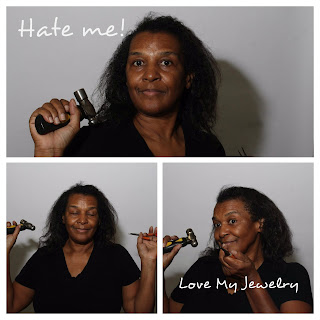Quality Control Counts in Jewelry Making
Your Seal of Approval
When you create beautiful, artsy jewelry it's exciting indeed, but don't forget the quality control. That's the necessary, must-do boring part of creating handmade jewelry.The idea of QC brings to mind inspector #6 affixing a seal of approval before the widgets leave the factory. It's pretty much like that, except it's your jewelry, your inspection and your final seal of approval.
Set a High Bar
No one is perfect. Sometimes things just break, but like Inspector #6, you must set high standards for every piece of jewelry you make. You should inspect every detail to make sure your jewelry meets those standards. Then if a mishap occurs, you can honestly say “Things like this rarely happen with my jewelry.”Your customers might not tell you
Quality control is important whether you make jewelry to sell to others or to wear yourself. If you don't care about your own jewelry, consider your poor customer.
Imagine her wearing the fabulous necklace you created for her special date. Then visualize it falling apart as she dances across the floor.
What if she trips over a bead and falls flat on her face? It's not a very pretty picture. What's worse is that your dancing customer may never tell you about her little jewelry mishap. In fact, you'll probably never hear from her again. But she will tell everyone else.
Here are a few additional ideas to consider:
QC gives you enough confidence to have a generous return policy
Some artists and crafters have a no return policy and that's not very good for business. Just create each piece of jewelry the best you can. Scan each piece for defects and correct them. You will sell your work proudly and feel good about offering a money back return policy. That will help generate more sales and your customers will love your jewelry so much you'll never have to make good on your guarantee.QC helps you become a better handmade jewelry artist
When you play the role of Inspector #6, you'll learn more about making jewelry. As you review your work, you may find weak areas, gaps or mistakes you might have missed. That can be a good thing. Finding these problems on “finished” pieces helps you develop a heightened sense of jewelry quality awareness. You'll learn to avoid making construction mistakes in the first place.QC helps you sell better
As you design beautiful pieces, create them, then go back to make sure the quality is up to par, you'll develop a new sense of pride in your work. That pride will show when you speak to customers at an art or craft show. It will show when you write a listing for an online craft site. People will be drawn to you and your work. They'll want to buy what you have to offer.Quality control is a simple time investment
Unless you have a professional shop with assistants on call, you'll most likely end up doing both the creative work and the quality control. You might as well learn to enjoy your QC routine the way you enjoy creating your jewelry.
A Quick Guide to Quality Control
Regardless of the price a person spends for your jewelry, they expect quality. They might not even know what that means until their earrings, bracelet or necklace falls apart. Then they can easily point to quality as the problem.Of course, you don't want that to happen, so here are a few questions to ask as you conduct your own personal quality control inspections.
Design
- Is this a good, creative design or was I in a hurry to throw something together?
Metals
- Is my sterling or gold shiny or does it need to be polished?
- Am I mixing gold with silver by design or by accident?
Loops
- Are my loops round? (No nines. No squares.)
- Are my jump rings closed tightly?
- Are my loops closed?
- Overlooked loop and jump ring gaps are the surest way for jewelry to fall apart.
Beads
- Are my beads the same color, shape, and length on both earrings?
- Are my beads chipped, cracked or discolored?
- Are they nice quality beads, not cheap looking?
Ear wires
- Am I using the same style and metal ear wire on both earrings?
General Construction
- Are my earrings the same length?
- Have I started to cut a piece of wire or chain and then changed my mind? A partial cut or gouge can leave a weak spot in your wire allowing jewelry to break easily.
- Did I fasten my crimp beads with crimp pliers to form round tubes instead of flat?
- Are my crimp beads tight enough but not too tight? Crimp beads that are too tight cut into beading cable causing it to break.
- Have I sanded and smoothed any rough wire or metal edges? (rough edges can injure your customer)
- Have I missed anything?
- Is this the best I can do?
Have fun!
The Nice Lady
©2018





Incredible site and a fascinating post. continue posting. Happy to peruse this article. Much thanks to you such a great amount for offering this post to us. handcrafted crosses
ReplyDelete